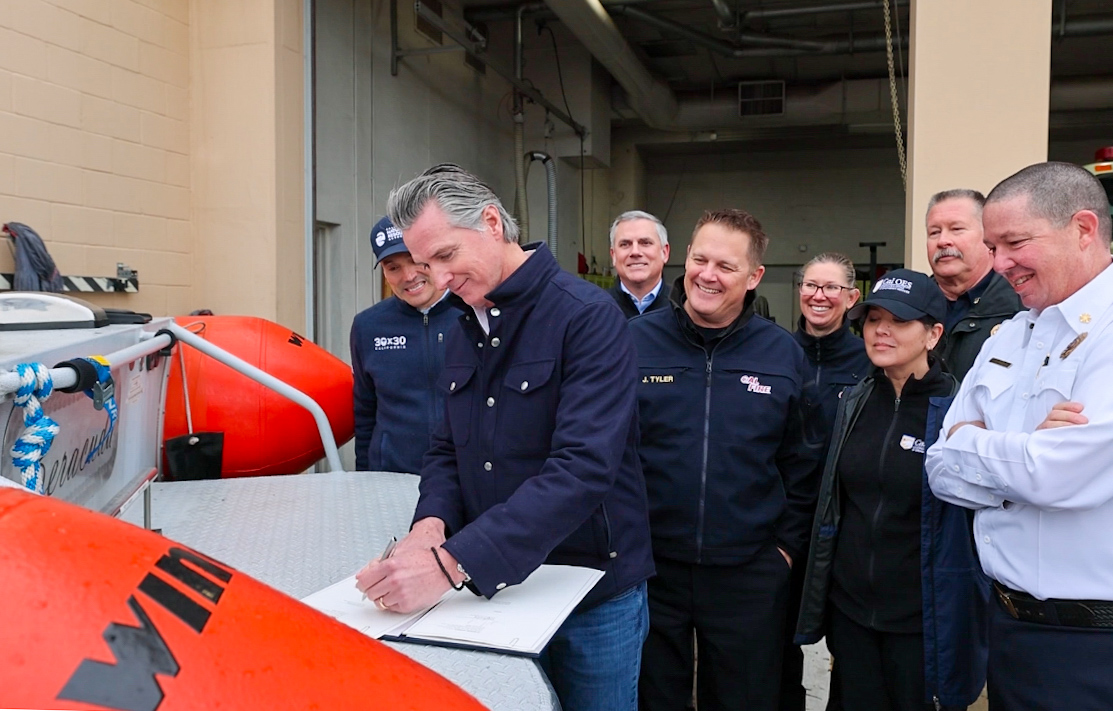Governor Newsom issues executive order to help California capture and store more water from upcoming severe storms
What you need to know: Governor Newsom issued an executive order to maximize the capture and storage of additional water from upcoming storms in Northern California.
SACRAMENTO — In anticipation of a multi-day, significant atmospheric river in Northern California, Governor Gavin Newsom today issued an executive order that would make it easier to divert and store excess water from incoming winter storms. The Governor signed the order after he received a briefing on the latest forecast for the storm.
The executive order also directs the Department of Water Resources and other state agencies to take action to maximize diversion of those excess flows to boost the state’s water storage in Northern California, including storage in San Luis Reservoir south of the Sacramento-San Joaquin Delta. These actions will help California replenish above-ground and groundwater storage that remains depleted in many parts of the state following multi-year droughts.
“It is more important than ever that we maximize every opportunity to recharge our groundwater supplies. As we anticipate rain and snow in Northern California, we are also preparing to use every last drop to boost our water supply for communities and farms throughout the state. By storing these stormwaters, we are creating a literal rainy day fund to help us recover from a multi-year drought and prepare for our hotter, drier future.”
Governor Gavin Newsom

Leveraging storms to capture more water
The National Weather Service is forecasting a moderate to strong atmospheric river to begin Friday and continue into next week. Prolonged periods of rain and mountain snow are expected, with the potential for flash flooding and rising creeks, rivers, and streams.
Recent above-average water years in 2023 and 2024 helped replenish the state’s reservoirs, but multi-year drought conditions continue to have significant impacts on communities with vulnerable water supplies, agriculture, and the environment. The latest science indicates that hotter and drier weather conditions could reduce California’s water supply by up to 10% by the year 2040. The frequency of extreme weather, including wildfires, in California demonstrates the need to continually adapt to promote resiliency in a changing climate. And today, the Department of Water Resources conducted the second snow survey of the season, which showed a snowpack well below average.
Governor Newsom is taking action now to ready the state and maximize the use of anticipated stormwater flows to help continue to boost the state water supply. Today’s executive order:
- Makes it easier for local and regional agencies to use existing state laws to maximize groundwater recharge. This builds on the Governor’s 2023 executive orders to support groundwater-recharge efforts in the context of that year’s unusually strong winter storms, as well as subsequent legislation codifying those efforts in state law.
Ensures the Department of Water Resources and other state agencies are taking full advantage of upcoming winter storms. Although reservoirs in Southern regions remain at historic capacity levels, this action allows for more water to be stored in other reservoirs statewide and helps replenish aquifers for water use.

More groundwater, more water storage
California has invested more than $9 billion to boost California’s water supplies over the past three years, taking aggressive action to prepare for the impacts of climate-driven extremes in weather on the state’s water supplies. In 2024, for the first time since 2019, California’s groundwater storage increased – a direct result of state and local actions to capture and store more water underground during last year’s historic wet season.
Today’s announcement continues the effective work of prior years. Since 2019, the Governor has allocated $1.6 billion for flood preparedness and response, part of the historic $7.3 billion investment package and to strengthen California’s water resilience. During previous wet seasons, Governor Gavin Newsom and the state have taken strong action to help local communities, expanding groundwater recharge by 1.6 million acre-feet through:
- Executive orders and legislation to capture more water. Governor Newsom signed executive orders to expand groundwater recharge by 400,000 acre-feet, as well as signing legislation to build more infrastructure.
- Fast-tracking groundwater recharge projects. The state streamlined groundwater recharge permits to allow for 1.2 million acre-feet of groundwater recharge, as well as investing in groundwater recharge projects.
- Maximizing stormwater capture. Investing millions for 67 stormwater projects to take advantage of major storm events.
- Ambitious goals. Setting the statewide goal to expand average annual groundwater recharge by at least 500,000 acre-feet as outlined in the Water Supply Strategy.
- Modernizing infrastructure. The state is advancing new projects to protect communities in the face of extreme droughts and floods. This includes the Sites Reservoir project, which will capture water during wet seasons and store it for use during drier seasons – holding up to 1.5 million acre-feet of water, as much as 3 million households’ yearly usage, and the Delta Conveyance Project, which will help protect water access, improve the capture and movement of water, and provide access to clean drinking water for 27 million Californians. Find more critical water infrastructure projects at build.ca.gov.
- Launching new data and innovative tools for tracking recharge action. The state has conducted 16,000 miles of geophysical surveys and developed new models and dashboards to deliver up-to-date data on California’s groundwater basins. These resources help local communities better understand their aquifer systems, identify fast paths for recharge, and support both local and statewide groundwater management efforts.
Preparing the state for storms
Governor Newsom is deploying resources and thousands of personnel to communities throughout Northern California in anticipation of the storm system.
Newly deployed resources include swift water rescue crews and fire engines in El Dorado County and Nevada County, as well as fire engines in Glenn County, added overnight. More resources will be deployed to further help protect communities.
Yesterday, Governor Newsom directed the Governor’s Office of Emergency Services (Cal OES) to coordinate state and local partners to deploy emergency resources to support impacted communities. State officials are urging people to take precautions now before the storm arrives, and to stay informed.
Go to ready.ca.gov for tips to prepare for the incoming storm.
